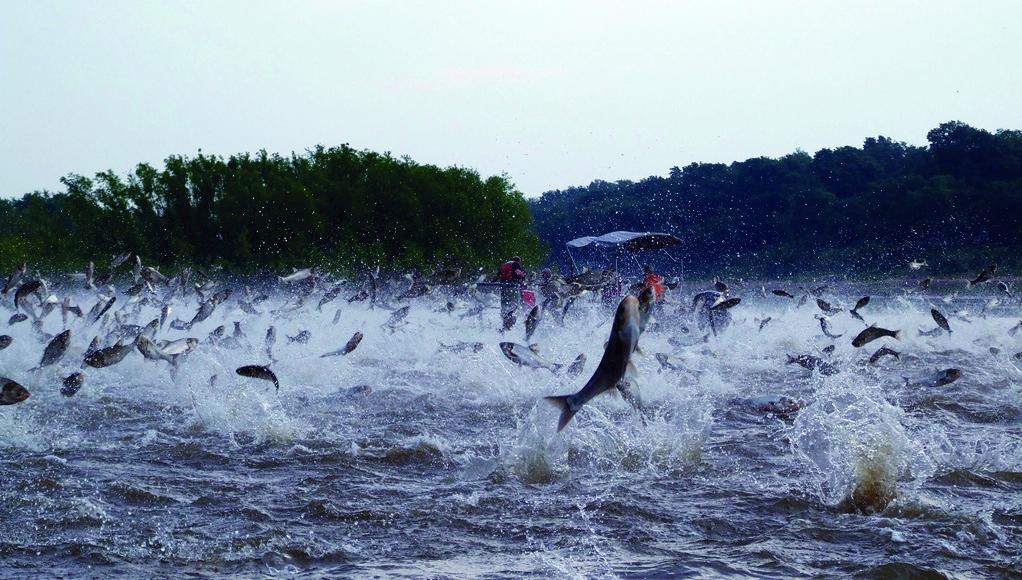Environmental detectives are using DNA to track invasive species
Asian carp leap out of the waters of the Illinois River.
From aquatic species to agricultural weeds to the Ebola virus, the US is dealing with the difficult environmental, economic and emotional effects of coping with invasive species.
Now, new environmental DNA techniques are allowing scientists to locate, measure and track many invasive species better than ever before. Scientists hope this could lead to better management and control and perhaps mitigate some of their economic and environmental harm.
In the United States, estimates suggest that the damage caused by invasive species amounts to about $1500 per household — similar to the cost to each household of the height of the Iraq war. The Great Lakes region alone harbors at least 186 invasive species, including the well-documented Asian carp and zebra mussels. Researchers estimate that the cost from ship-borne invasive species to states around the Great Lakes is between $100 million to $800 million per year.
David Lodge, director of the Environmental Change Initiative at the University of Notre Dame, says that he and many other research groups have advanced DNA science to the point that it would be possible, if the current technologies were fully used, to avoid much of the damage done by invasives.
“We need to think in terms of preventing species from arriving in the first place,” he says. “But when that fails, as too often is the case, we are stuck wondering, ‘Where is that Asian carp? Where are those species?’ In order to manage well you need to be able to measure where they are. We're using DNA to do that.”
Their technique is analogous to what forensic scientists do every day at crime scenes, Lodge says. “We and every organism leave a ‘cloud’ of DNA behind us, if you will. In the aquatic environment, where it's very difficult to directly observe organisms, this turns out to be a very sensitive tool for detecting the presence of an organism.”
Scientists can extract DNA from water samples and look for the fragment of DNA that is the “fingerprint” of the species they are looking for. For example, Lodge says, the first version of this technique, which he and others pioneered at Notre Dame, used Asian carp as their target. They extracted all the DNA from water samples taken in the Chicago canal and were then able to isolate the DNA that belonged to just that species.
These new environmental DNA techniques are also allowing scientists to answer some other knotty questions. For example, if DNA is present in the water, does that mean the species is present right there, right now? Or could it be miles away? How long does the DNA last in the environment?
A few years ago, Lodge says, these were quite controversial questions because researchers couldn’t provide answers. In the last couple of years, however, “we have learned those answers through experiments and observations,” Lodge says. “In general, we believe that when DNA is detected, it's quite a reliable indicator of the presence of a living organism nearby in the not-too-distant past.”
Scientists now know that DNA in water samples degrades and becomes undetectable in a matter of hours or days after an organism — a fish for example — is removed from the water. So the presence of DNA is “a signal that is almost in real-time,” Lodge says.
He and many other collaborators have also pioneered an approach they call "species profiling." This approach creates an “index of invasiveness,” or the likelihood that a specific species is going to cause harm. “We do that by looking at the characteristics of species,” Lodge explains. “If we use history as our guide, what we've discovered is that the species that turn out to be harmful actually have different sets of characteristics than those that will be benign.”
Environmental agencies and national governments elsewhere in the world are increasingly using these indexes to screen species that have been proposed for importation. The countries then gain the benefits of commercial business by allowing the species that won't cause harm to come in, while preventing, or otherwise managing, species that likely would be harmful.
Finally, Lodge notes, we must be mindful that the movement of species is a two-way street. Species native to the Americas can be invasive to other countries, and we are likely exporting at least as many as we are importing. We hear a lot in this country about Asian species because we have a lot of trade with Asia, but the Chinese are suffering a great deal from North American species because the trade goes in both directions.
“Their pine forests are being attacked by beetles from North America. They've got Louisiana crayfish eating their rice. They've got American bullfrogs. They've got all kinds of harmful species from North America,” Lodge says.
One of the great concerns of today's interconnected world is that when people move around the planet, we bring things with us, either intentionally or accidentally, that can cause us great harm — the Ebola virus being the most timely example of this reality.
“There are many benefits to globalization,” Lodge concludes. “But there are some side effects of globalization that require better management if we're to fully realize these benefits.”
This story is based on an interview that aired on PRI's Science Friday with Ira Flatow
